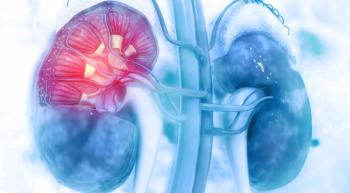
Patients With nmCRPC Achieve Longer Treatment Duration With Darolutamide
The rates of treatment discontinuation were higher with enzalutamide and apalutamide than with darolutamide for patients with non-metastatic castration resistant prostate cancer.
Darolutamide (Nubeqa) was associated with longer time to treatment discontinuation in patients with nonmetastatic castration-resistant prostate cancer (nmCRPC) according to a real-world analysis of androgen receptor inhibitors (ARIs), which compared the agent with enzalutamide (Xtandi), and apalutamide (Erleada).
The proportion of patients who discontinued initial ARI treatment was 30.4% for darolutamide compared with 40.8% for enzalutamide and 46.0% for apalutamide.
The investigators also reported that the proportion of patients who progressed to metastatic prostate cancer (mCRPC) was lower with darolutamide (17.7%) compared with enzalutamide (28.3%) and apalutamide (27.8%). In addition, a Cox proportional hazards model that adjusted for baseline factors indicated that patients receiving darolutamide had a 40.6% lower risk of progression to mCRPC over time vs enzalutamide and a 35.3% lower risk of progression to mCRPC vs apalutamide.
The findings, from the Comparative Real-world Evidence of Darolutamide, Enzalutamide, and Apalutamide for Nonmetastatic Castration-Resistant Prostate Cancer Patients in the United States (DEAR), were presented during the 2023 American Society of Clinical Oncology Annual Meeting by Alicia K. Morgans, MD, MPH.
“There is limited real-world evidence on ARI discontinuation, the underlying reasons for discontinuation, the incidence of adverse events or AEs, and disease progression for different ARIs. DEAR is the first real-world study using a single data source to compare utilization, outcomes, and incidence of AEs for the 3 ARIs currently approved for the treatment of nonmetastatic CRPC,” said Morgans, genitourinary medical oncologist and the medical director of the Survivorship Program at Dana-Farber Cancer Institute in Boston, Massachusetts.
For the study, the investigators included adult men who received a diagnosis of nonmetastatic castration-resistant prostate cancer (nmCRPC) and who initiated an ARI therapy for the first time during the patient identification period.
The investigators analyzed the proportion of patients who discontinued initial ARI treatment and the reasons for discontinuation, proportion of patients who progressed to mCRPC, time to initial ARI discontinuation, time to progression to mCRPC, and incidence of AEs.
A total of 870 men were included in the study, 362 of whom received treatment with darolutamide, 382 with enzalutamide, and 126 with apalutamide. Morgans reported that “observed demographics, baseline characteristics, and duration of follow-up were similar across the 3 treatment cohorts.” The time from diagnosis of prostate cancer to the index date, as well as the time from nmCRPC diagnosis to the index date were found to vary slightly across the 3 cohorts.
“A Cox proportional hazards model adjusting for baseline factors showed that patients on darolutamide had a 27.4% lower risk of discontinuing initial ARI treatment over time compared with enzalutamide and a 39.1% lower risk compared with apalutamide,” Morgans said.
AEs were the most common reason for nmCRPC treatment discontinuation, occurring in 10.2% of patients receiving darolutamide, 14.4% of patients receiving enzalutamide, and 15.1% of patients receiving apalutamide.
In all, 24.9% patients receiving darolutamide experienced any AE vs 29.3% and 30.2% of patients receiving enzalutamide and apalutamide, respectively.
Limitations of the study discussed by Morgans included the fact that although the analysis adjusted for observed differences in baseline characteristics among the treatment cohorts, “unobserved confounding factors that may influence treatment duration and clinical outcomes in the absence of randomization,” according to Morgans. Another limitation is the ability to generalize the results to other patient populations.
“Future studies are needed to confirm these results in other populations or using other data sources,” Morgans said.
“In conclusion, darolutamide was associated with a longer time to treatment discontinuation and a longer time to progression to mCRPC compared with enzalutamide and apalutamide in a real-world setting,” she added.
Reference
Morgans AK, Shore ND, Khan N, et al. Comparative real-world (RW) evidence on darolutamide (Daro), enzalutamide (Enza), and apalutamide (Apa) for patients (Pts) with nonmetastatic castration-resistant prostate cancer (nmCRPC) in the United States: DEAR. J Clin Oncol. 2023;41(suppl 16):5097. doi:10.1200/JCO.2023.41.16_suppl.5097
Newsletter
Knowledge is power. Don’t miss the most recent breakthroughs in cancer care.






























































































